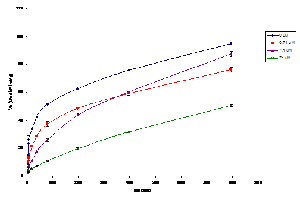
Over the past 25 years, a number of vanadium complexes have been shown to be “insulin mimetic”, that is, to diminish blood glucose levels, when administered as therapeutic agents. More recent studies have shown that these complexes do not actually mimic insulin, but merely enhance the effects of the small quantities of insulin that are present. A variety of coordination complexes containing combinations of N/S/O donor sets all seem effective in reducing blood glucose levels regardless of which donor set is employed. Complexes with ligand systems including dithiolenes (S/S), cysteine-amines (S/N), picolinates (N/O), catecholates (O/O), salen (N/O), and guanidine (N/N) have all been employed, all almost exclusively with V(IV) and V(V) systems. The disparate nature of the ligands suggests that it is the metal center and not the ligand that is playing the dominant role in therapy. It is the goal of this work to gain an understanding of the oxidation under physiological conditions of a series of V(III) species with well-understood ligands and then implement the acquired knowledge in the synthesis of vanadium coordination complexes to be studied for bio-mimetic insulin-enhancing properties. We have synthesized a number of complexes so far and have been investigating their alkaline phosphatase inhibition properties as prima facia evidence for the ability to be useful as insulin enhancing agents. We have been studying the systems at varying pH and temperature. Promising candidates can then be investigated using the more physiologically relevant protein phosphatases.
Enzyme Inhibition Studies
Following the synthesis of complexes, both known and novel, we have been employing these complexes as inhibitors of both alkaline and acid phosphatases in collaboration with ISU colleague Marjorie A. Jones.